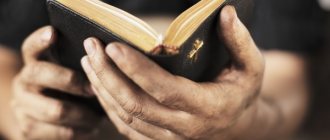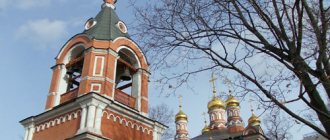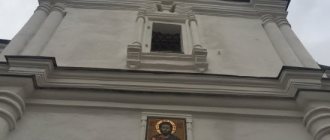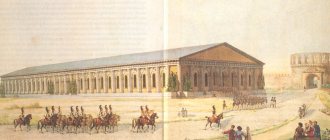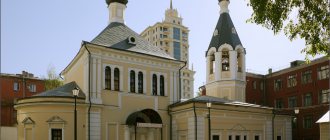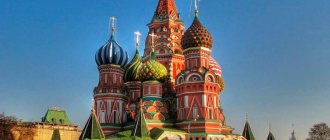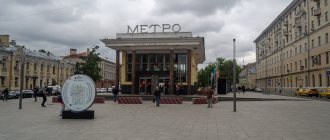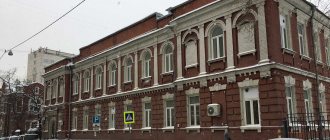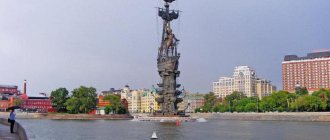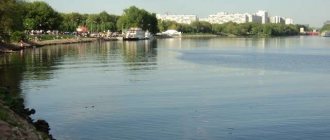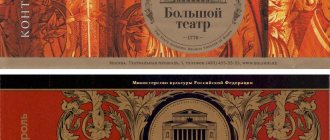| Moscow Resurrection Church in Kadashi, August 27, 2011. Photo by A.P. Sychev from the site sobory.ru |
Moscow Church in honor of the Resurrection of Christ, in Kadashi
of the Moskvoretsky deanery of the Moscow diocese
- Thrones:
- Resurrection of Christ (upper church),
- Dormition of the Blessed Virgin Mary (main altar of the lower church),
- Tikhvin Icon of the Mother of God and St. Nicholas (altars of the lower church)
The first mention of a wooden church is in a letter from the Moscow governor, Prince Ivan Yuryevich Patrikeev, to his sons, drawn up in 1493, where it is called “the Church of the Resurrection, on Gryazekh”
. This name was associated with the spring floods of the Moscow River and the close location of the temple to the swampy shore. And since 1625, regular entries about the temple appear in the Patriarchal salary books.
The first stone church was built in 1657. In 1687, the modern church was founded, the old one was dismantled. The temple was founded by Patriarch Joachim and consecrated by Patriarch Adrian in 1695. The southern asp and a fragment of the southeastern corner of the quadrangle, preserved from the ancient church of 1657, were built into the new building. And in 1695, a slender six-tiered tented bell tower was built, which was popularly called “candle”. In the 19th century galleries and a porch were completed.
The Kadashevsky Church was famous for its interior decoration, which the parishioners and benefactors of that time took great care of. Royal isographers were invited to paint the walls and paint icons, which indicates the special closeness of the Kadashevites to the royal court. The six-tiered carved iconostasis stood out with particular beauty, which has been described as one of the best works of carved art of the 17th century.
The ancient painting of the 17th century, made by royal isographers, was damaged in a fire in 1812 during the French invasion and was replaced by new painting by the artist P.N. Shepetov in 1848 under the rector Fr. Ioanna Margaritov.
The last construction work in the temple was carried out in 1860 under the leadership of architect N.I. Kozlovsky. The ancient walls of the galleries were broken, and the new ones were set back by 3.2 meters for expansion purposes. The church building has survived in this form to this day.
| View of the Church of the Resurrection of Christ in Kadashi from the 1st Kadashevsky Lane, photo 1882 from Naydenov’s album |
At the beginning of the 20th century.
Priest Nikolai Smirnov (1868 - 1922), popularly nicknamed "Kadashevsky", becomes the rector of the Church of the Resurrection. He earned the special love of Orthodox Moscow for his tireless and varied pastoral activities. Under him, a sisterhood was established, an almshouse, an orphanage were opened, and during the 1st World War two infirmaries for the wounded were opened. He received particular fame for organizing numerous pilgrimages to Russian shrines, in which up to two thousand people took part. Despite all the efforts of the parishioners, the temple was closed in 1934. Most of the temple’s icons were lost, the few remaining were scattered and stored in the storerooms of the Tretyakov Gallery, the Historical Museum and the Ostankino Museum.
After its closure, the temple housed various government institutions, including such as the “sausage factory sports club.” All this could not but cause the desolation and destruction of the temple.
In 1966, the Resurrection Church was leased to the All-Russian Scientific and Cultural Center named after Academician I.E. Grabar, a leading scientific institution for the restoration and preservation of artistic values.
On February 6, 1992, the parish community of the Kadashevsky Church was registered and documents were signed on the transfer of the church to the believers. But, despite all the efforts of the rector and parishioners, the temple continued to remain closed for more than twelve years.
To perform divine services, the church community converted one of the nearby buildings into a church. New church dedicated to St. Job of Pochaevsky, with the verbal blessing of His Holiness Patriarch Alexy, is the only temple in Moscow of this great Russian saint. The Pochaev image of the Blessed Virgin Mary is especially revered in the church, for which a separate chapel was built.
Only in 1996, after incredible efforts, the parish was allowed to enter the Church of the Resurrection to perform divine services.
The turning point for the parish was 2004, when, through the efforts of parishioners with the support of other Orthodox parishes and brotherhoods, the process of liberating the Kadashevsky Church began. In December 2004, regular services were resumed in the upper Church of the Resurrection of Christ in Kadashi. Currently, the lower temple is being gradually liberated.
Through the joint efforts of the parish and the Society of Devotees of Orthodox Culture, the magazine “World of God” is published, dedicated to Orthodox culture and the modern life of the Church. The historical and archaeological museum “Kadashevskaya Sloboda” has been created at the temple, and Sunday school classes are conducted. Annual Kadashev readings are held, dedicated to the architectural heritage of the capital.
Sights of Kadashevskaya Sloboda
Leaving the Tretyakovskaya metro station, you will find yourself in Kadashi. Kadashevskaya Sloboda is the largest and richest of the settlements in Zamoskvorechye; in the 17th century it occupied the territory between Bolot, Polyanskaya Square, Ordynka and Yakimanka.
Kadashi and Yakimanka - a tour of the streets and alleys of Moscow
Initially, the settlement was inhabited by Kadashis (coopers); in 1613, a weaving industry appeared here, supplying the royal court with linen products. At the beginning of the 16th century, Kadashi merged with the Tolmachi located to the south - a settlement of interpreters (translators) that existed since the 14th century and served the Zamoskvoretsk Tatar Horde.
Between Kadashi and the Streltsy settlements located near the wall of Skorodom, until the 19th century, there remained an undeveloped space - “in the open”, which served as a communal pasture for livestock. In the 18th century, noble estates began to be built along the radial streets, while in the depths of the alleys the suburban way of life was preserved.
The construction of the Vodootvodny Canal made the floodplain west of Yakimanka suitable for development. In the 1880s, exhibition buildings for the Tretyakov Gallery began to be built on Lavrushinsky Lane. Its reconstruction in the 1980s–2000s left its mark on the entire appearance of the area.
Our walk begins in Kadashevsky lanes. Even before the formation of Kadashevskaya Sloboda, the center of Zamoskvorechye became the Church of the Resurrection of Christ (2nd Kadashevsky Lane, 7). The current church, built in 1687–1695, is an outstanding monument to the formation of the Naryshkin Baroque.
The traditional type of cuboid, five-domed church, designed as a “ship”, is enriched here with new forms of white stone decoration. The Kadashevsky temple was famous for its interior decoration.
Royal iconographers were invited to paint the walls and paint icons. Nowadays, the icons of the Resurrection Church are scattered and stored in the storerooms of the Tretyakov Gallery, the Historical Museum and the Ostankino Museum.
Next, go to the Vodootvodny Canal . It was laid in the 1770s along the swampy oxbow of the Moscow River, when it was necessary to repair the supports of the Bolshoy Kamenny Bridge that had collapsed in the flood of 1783.
The length of the canal is 4 km, width is 30–50 m. It made it possible to divert part of the excess water and made the floodplain to the west of Yakimanka suitable for development. The Babyegorodskaya and Krasnokholmskaya dams with locks built at the beginning and end of the canal made it navigable (they were dismantled in the 1930s). As a result of the construction of the canal, Balchug Island was formed.
The historical buildings of Kadashevskaya Embankment, which consisted mainly of one-two-story mansions, were partially destroyed in the post-war years and finally in the “dashing” 1990s.
Church of the Resurrection in Kadashi
If you look at Zamoskvorechye from Borovitsky or Kremlin hill or, for example, from the Bolshoy Kamenny Bridge, then among the roofs of the houses you can see the golden domes of the Church of the Resurrection of Christ in Kadashi and the cross of the bell tower rising into the sky. These domes shine in a very special way against the background of the nondescript roofs of the houses standing nearby. Some inexplicable force beckons you to definitely go and find this church and look at it up close. This is not so easy to do! You still have to get lost in the narrow labyrinths of Kadashevsky lanes and dead ends. But the search result will not disappoint anyone, as soon as we find ourselves in the temple courtyard. It is in such places that you can find fragments of ancient Moscow.
On the territory of the Kadashevskaya settlement there were several churches: Joachim and Anna, in Yakimanka, Cosmas and Damian, in Kadashi, etc. But the center of the settlement became the Church of the Resurrection of Christ. Previously, it was called “what is on Gryazekh”, because Kadashi was located not far from the oxbow of the Moscow River, which overflowed every spring, bringing dirt to the settlement. The Church of the Resurrection in Kadashi served as the main vertical and compositional dominant of Zamoskvorechye. In addition, it determined the main urban axis of Moscow: from the bell tower of Ivan the Great to the palace Church of the Ascension in Kolomenskoye.
The Church of the Resurrection of Christ in Kadashi was of paramount importance in the architectural and artistic appearance of Zamoskvorechye, which gave it a special privilege. From time immemorial in Moscow, the ringing of bells, calling believers to matins, began from the famous bell tower of Ivan the Great, and the rest of Moscow churches waited with bated breath and trepidation for the first strike of the Assumption bell. After this, the bells of Strastnoy, Vysoko-Petrovsky and other large monasteries echoed with the ringing. Well, after them, the bells of the Church of the Resurrection in Kadashi began to sing, and only then all the other posad churches in the city.
The first mention of a temple on this site dates back to 1493. In 1654, the plague raged in Moscow. “But while everyone was coming from the west with happy news, from Moscow they let it be known that a pestilence was raging here... At the beginning of September, Prince Pronsky let the queen know that the pestilence in Moscow was intensifying, there were few Orthodox Christians left,” testifies S. M. Soloviev. According to some reports, two-thirds of Muscovites died from the plague. This also affected the residents of Kadashevskaya Sloboda. It is amazing how quickly the Kadashevites coped with such a serious disaster, because already three years after the tragedy, in 1657, they rebuilt the wooden church.
Thirty years later, with their own efforts and resources, the residents of Kadashevskaya Sloboda erected a new architectural miracle. The name of the architect of the stone Church of the Resurrection in Kadashi was lost in the labyrinths of history. It is believed that he was the architect and “bell maker” hieromonk Sergius Turchaninov, a native of Kadashi. In the 1970s, the architectural historian and restorer Galina Vladimirovna Alferova created the work “Monument of Russian Architecture in Kadashi. The history of its restoration”, dedicated not only to the Church of the Resurrection itself, but also to the entire Kadashevskaya Sloboda. Alferova collected information about Kadashi in the archives bit by bit.
Galina Vladimirovna made undeniable, convincing conclusions about the reason for the appearance of a unique architectural creation in Zamoskvorechye: “Such a highly artistic architectural monument in Kadashevskaya Sloboda did not arise by chance, but was the embodiment of an artistic idea, as an artistic image that absorbed the creative quests, thoughts and contradictions of the brilliant author, son of his time. One cannot help but marvel at the taste of the architect and the customers - the weavers of Kadashevskaya Sloboda, who rose in their aspirations to such a high level of artistic feeling, aesthetic views and a unique ideal of beauty!
The temple is divided into two tiers on two floors: the lower one is simple and austere and the upper one is more solemn. These are two worlds - the low and the high. As on Russian icons, the higher the image is, the larger and more majestic it is, so in a church, the higher, the more beautiful, graceful, and regal. The architect, like the ancient icon painter, wanted attention to be focused on what is above, so the lower part of the temple is simple and uncomplicated: the only decorations here are discreet window frames. But the higher we look, the richer the decorations become. Near the domes, the pattern becomes quite ornate with many through sections, creating a complex composition of the pattern.
During the construction of the Church of the Resurrection, a synthesis of architectural styles took place - traditional Russian and Baroque, characterized by decorativeness, sublimity, and grace. The baroque details of the temple are, first of all, white stone carvings in the form of curved ridges - the famous “cockscombs”, as they were popularly called. The external white stone decorations of the walls and columns are made in the form of a vine shoot - one of the most common symbols of Christianity. For comparison, we can recall the iconographic type “Christ the True Vine.” “I am the true vine, and My Father is the vinedresser,” says the Gospel.
Architect V.I. Bazhenov, who designed the neighboring Church of the Icon of the Mother of God of the Joy of All Who Sorrow, often came to the Church of the Resurrection of Christ in Kadashi and called it “a building that has “pleasantness,” including because of the decorativeness of its forms. Five octagons end with five onion domes, which form a complex compositional group. Each of the chapters of the church seems to stretch upward. One of the octagons is located significantly higher than the other four, so it seems as if the side domes are trying to reach the central one, which goes like a cross into the sky, and there is a feeling of growth of the chapters and the church as a whole.
Thus, the entire architectonics of the building is aimed at creating the effect of the church aspiring upward - towards heaven. The same can be said about the decor system. The decorations seem to climb up the walls, making the church look solemn. “The volumes seem to lose their massiveness, characteristic of the architecture of the mid-17th century, and a visual impression arises as if the building was built of thin walls. The composition of the monument is created in such a way that the wall dominates in the lower parts (its significance gradually weakens as it moves upward), and the decor dominates in the upper part. This is how the architect achieves the impression that the monument moves, lives, grows, “blooms,” notes Alferova.
The walls of the church were painted with red lead, and against a red-orange background the golden domes, which looked either against the sky or against the background of the wall of the central drum, amazed with their brilliance and splendor. The seams between the bricks on the temple walls were painted with cabbage roll. It seemed that the entire building was shrouded in a light bluish haze. It was as if the sky had descended to earth. It was impossible to simply go into the temple - first you had to walk around it almost in a circle and look around it all from the outside. In the Church of the Resurrection, the architect embodied the principle of unity of the exterior and interior. Even the design of the decoration of the main entrance to the church was almost identical to the design of the wooden decorations of the iconostasis inside.
Anyone entering the church was amazed at its internal and external integrity. Inside, as well as outside, the gaze was directed upward. There were three staircases leading to the second floor, so I couldn’t help but want to go up. At the top, parishioners were greeted by a huge, brightly lit gilded iconostasis, painted by the masters of the Armory Chamber - students of Simon Ushakov. Of particular artistic value were the wooden posts that separated the icons from each other. They were made of solid wood and empty inside. The carvings were vine weaving, just like those on the walls outside. The iconostasis was gilded with red gold leaf, the uncarved parts were painted blue.
No less magnificent was the painting of the church walls, done by court painters. Unfortunately, the painting was lost in a fire in 1812 and was replaced in the mid-19th century. This peculiar effect of brightness, colorfulness, and festivity, contrasting with the simplicity of the first floor and the refectory, amazed everyone present in the temple. The ancient iconostasis suffered from Napoleonic barbarians and during the Soviet persecution of the church. If you want to have an idea about the iconostasis of the Church of the Resurrection, you can go to the Donskoy Monastery: in the cathedral in honor of the Don Icon of the Mother of God, one of the iconostases is made according to the model of the Resurrection.
In 1695, three staircases leading to the second floor were removed, and a high (more than forty-three meters) six-tier bell tower was built, which was popularly nicknamed the “big Moscow candle.” Slender, graceful, soaring up, it is still one of the main high-rise landmarks of Zamoskvorechye. The composition of the church has changed significantly; it has taken on the typical appearance of a “ship”. “The upward movement seemed to slow down, and the whole structure became somewhat heavier. Its original image has changed significantly, although the building has not lost its artistic expressiveness,” Alferova writes about the changes at the end of the 17th century. The lower tier of the bell tower and the church were united by a gallery, which could only be accessed by a special staircase. The bell tower of the Church of the Resurrection is similar in shape to the corner Beklemishevskaya tower of the Kremlin. Perhaps the architects intended another axis from the Kremlin through the bell tower. From the forty-meter height of the “big Moscow candle” the Kremlin and Zamoskvorechye were clearly visible. The main bell of the temple, weighing more than four hundred pounds, was cast in 1750 by the same master who, a few years later, would create the famous Assumption Bell of the Ivan the Great Bell Tower. At the beginning of the 20th century, Moscow virtuoso bell ringer K.K. often played here. Saradzhiev.
Two bells of the Church of the Resurrection with a total weight of five hundred and fifty-nine pounds are now in the Bolshoi Theater, where they were transferred for temporary use in 1938. In 1812 the church was looted. The French stole most of the valuables, expensive utensils and icons. A stable was built in the Tikhvin chapel of the lower church. Leaving Moscow, the French set fire to the temple, but miraculously the fire went out and did not reach the iconostasis. As a result of restoration work in the 19th century, the appearance of the temple changed: the circular passage around the upper church disappeared, the stairs on both sides of the bell tower were dismantled and covered porches with a semi-dome top were built.
In the book of the great collector of Russian words and folk wisdom V.I. Dahl’s “Collection of proverbs, sayings, sayings, proverbs, sayings, riddles, beliefs and other things” you can find an interesting proverb: the truth came not from Peter and Paul, but from the Resurrection in Kadashi. It turns out that in the parish of the Resurrection Church lived the Moscow mayor of 1843-45, Andrei Petrovich Shestov, who went down in history thanks to a quality rare for Russia - he did not steal and did not allow others to do so. This is how the writer and ethnographer S.M. explains the origin of the proverb “The truth came not from Peter and Paul, but from the Resurrection in Kadashi.” Maximov in the book “Winged Words”: “Shestov did not notice, and did not want to hear or see, that enemies were gathering against him and warlike campaigns were being undertaken. He looked at the city treasury with a merchant's eye and guarded and multiplied it so that when at the end of the first year they began to count it, a wondrous thing happened, an unheard-of event: the treasury grew to a large size from accumulations and savings and from smart farming. Shestov himself achieved great fame and fame, and his name became known even to small children. And – it’s a joke! - because of him, the Moscow people turned upside down the old proverb, already firmly established on its feet: “the truth went to Peter and Paul, but lies spread across the earth.”
At the beginning of the 20th century, the rector of the temple was Archpriest Nikolai Smirnov, popularly nicknamed Kadashevsky. Father Nikolai was distinguished by exceptional energy, he never got tired, he walked ahead everywhere, without weakening for a minute. He had great talents: he was an excellent singer, reader, preacher, inspired performer of worship, prayer book, confessor, writer, organizer, administrator and public figure. He was distinguished by his tireless and varied activities: he organized a sisterhood that cared for the sick and elderly, created a folk choir, and opened an infirmary at the church for the wounded during the First World War. Bishop Arseny Zhadanovsky recalled: “The Kadashevsky Church, like other churches, was little visited by parishioners and was not a school of piety for them. Then Father Nikolai decided on the next radical act. “If people are lazy towards the word of God, I will go to them myself.” And he went to Kanava, to the taverns adjacent to Kadashi, and there he began to perform evening services. This was bold and caused many different rumors in society, but Father Nikolai was not afraid, was not embarrassed, comforted by the zeal of his new spiritual friends, who did not like the inspired service of the good priest in teahouses and canteens, where they later opened auditoriums for moral readings with the display of light paintings.” .
At the end of 1934 the church was closed. During Soviet times, the building was occupied by government agencies, the archives of the State Security Committee, and even a sports club of a sausage factory. After the Great Patriotic War, restoration work took place in the temple under the leadership of the already mentioned Galina Alferova, a famous restoration architect. Experts tried to give this magnificent architectural monument a 19th-century appearance. In 1964, the All-Russian Art and Scientific Restoration Center named after Grabar was located in the restored temple building. The institution designed to preserve cultural monuments treated the church barbarously. In 1966, an article by the famous artist P.D. appeared in Komsomolskaya Pravda. Korina, in which he wrote: “There are Kadashis in Moscow. The 17th century cathedral, famous for its beauty. Now Kadashi is under threat. There is no need, I believe, to set up carpentry workshops on the first floor of the cathedral. Chemical processes, vibration, and the laying of sanitary pipes can be disastrous for a building that, according to archaeological research, stands on sand.” Until the early 1990s, the temple and its entire territory were occupied by industrial enterprises. Hastily built storage buildings appeared around the church. Part of the fence and gate were lost.
In the church yard, only the house that belonged to the priest remained. The metal structures supporting the partitions in the temple were broken, and there is still a threat of the building collapsing. But until the early 2000s, a chemical laboratory with X-ray equipment operated in the temple. In 1992, at a meeting of parishioners, the parish of the Church of the Resurrection was re-formed. The rector became Archpriest Alexander Saltykov, a professor of church art who advocates for the restoration of the architectural masterpiece in Kadashi. The parishioners cleared the church yard of industrial debris and waste, but the church was still occupied by the VKHNRTS. The restorers did not intend to return it to believers, despite the decree of the President of the Russian Federation B.N. Yeltsin from 1993, according to which all churches were transferred to the Russian Orthodox Church. First, the restorers provided the community with one of the chapels of the church, and before the service, parishioners were given one-time passes to the “security facility.” After the service, the employees of the VKHNRTS used the room in which the Divine Liturgy took place for their work needs, and smoked right on the spot where the throne had stood some time ago. In 1996, Father Alexander consecrated one of the barns, which became the Church of St. Job of Pochaev.
Services resumed, and little by little the spiritual life of the parish, huddled in the carriage house, was improved. And next door, in a huge temple, restorers were grilling kebabs on the grill on the porch. The clergy and the church community have repeatedly appealed to all authorities, but to virtually no avail. For eight years, services were held in the Church of Job of Pochaev, and only in 2004, by order of President V.V. Putin, the temple was handed over to the community. But this was preceded by independent attempts by parishioners to return the church. On August 2, 2004, believers blocked the path for VKHNRTS workers to the temple, fenced it with barbed wire and locked the gate. Father Alexander performed a prayer service for the liberation of the Church of the Resurrection in Kadashi, and the icons were reinstalled. The law was on the side of the parishioners, since the contract between the All-Russian Scientific and Cultural Center and the Department of State and Municipal Property of the city of Moscow expired back in 2001. A new page in the history of the Church of the Resurrection in Kadashi has opened. When parishioners first entered the upper church, vacated by restorers, they were amazed at the chaos that was happening there: cigarette butts, empty bottles, rubbish and garbage were lying right in the altar. In place of the throne stood a billiard table. It took a lot of effort to put the temple in order.
The problems of the Kadashevites are not over. According to the news portal lenta.ru: “The clouds gathered over Kadashi back in the first half of the 2000s, when it came up with a project for the construction of the elite residential complex “Five Capitals.” Investors were going to build five houses up to six floors high. Along with the apartments in Kadashi, they planned to build an entertainment center with a restaurant, a music salon and a winter garden, as well as a sports complex with a gym, a swimming pool with a paddling pool, a sauna and a spa center. Five residential buildings were supposed to surround the Church of the Resurrection and absorb the 300-year-old chambers of the Olenevs.” The semi-abandoned buildings of the Soviet industrial plant, located on the territory of the Church of the Resurrection in Kadashi, were privatized in the 1990s. Historical buildings near the temple (the deacon's house of the 19th century, the Olenev chambers of the 18th century, etc.) were under threat of demolition. Thanks to the dedication of the residents of Kadashi, who several times barricaded themselves in houses illegally intended for demolition and fought with their bare hands against the hefty employees of the private security company, the destruction of architectural monuments was stopped. Soon the Russian Prosecutor's Office banned the construction and demolition of ancient buildings on the territory of Kadashevskaya Sloboda.
The Church of the Resurrection received a passport as an architectural monument of federal significance, defining the boundaries of its territory and prohibiting any construction on it. These events were called the “Battle of Kadashi”. In 2009, discussion of the project for the construction of an office and residential center resumed, since, according to the conclusions of the expert commission, the buildings to be demolished do not bear historical and cultural value. Some ancient buildings have already been irretrievably lost. Kadashi defenders believe that the construction of a residential complex will destroy the architectural ensemble of Zamoskvorechye and could damage the foundation of the Church of the Resurrection. The question still remains open. Residents of Kadashi especially fiercely have to defend the building of the former sausage factory of merchant N.G. Grigoriev, built in 1878 behind the Church of the Resurrection. At the beginning of the twentieth century, Grigoriev’s factory was the largest sausage enterprise in Moscow - it accounted for almost half of all products produced. We may never see this 19th-century architectural monument again. Recently, the Kadashevskaya Sloboda Museum, a local history museum of Zamoskvorechye, opened at the Church of the Resurrection. Here is a collection of church items found during renovation work in the 2000s.
The Church of the Resurrection in Kadashi houses many shrines. For example, particles of the relics of the Optina elders, the Venerable Confessor Gabriel, Archimandrite Melekessky, and the Venerable Job of Pochaev. In addition, the church has several especially revered icons: the image of the holy Tsar-martyr Nicholas, painted on a brick from the destroyed Ipatiev house in Yekaterinburg, where the martyrdom of the royal family ended; Our Lady of Pochaev, Tikhvin Icon of the Mother of God - the throne icon of the temple. It is a pity that the revered image of the Mother of God of Kadashevskaya, which was located in the Resurrection Church before the 1917 revolution, is now kept in the Historical Museum.
Luzhkov Bridge and Bolotnaya Square
Cross the pedestrian Luzhkov Bridge (it was built in the 1990s; the name, formally indicating the meadows that once existed here, also hints at the name of the then Moscow mayor) go to Bolotnaya Square .
It is located on the site of a marshy meadow, which in the 15th–18th centuries in winter was a place of trading, public entertainment and public punishment of criminals. On January 10, 1775, the leader of the Cossack rebellion, E. I. Pugachev, was executed on the square. In the 19th century, stone shops and warehouses were erected on the square.
In Soviet times, a park was laid out on the square, in the center of which there was a monument to I. E. Repin, representing the figure of an artist with a palette and brushes in his hands at an easel with a drapery thrown over it.
In 2001, in the eastern part of the square, a sculptural composition by M. M. Shemyakin “ Children are victims of the vices of adults ” was installed: two children playing blind man’s buff, surrounded by a host of allegorical monsters - personifications of vices.
There are 4 floating fountains in the water area of the Vodootvodny Canal adjacent to the square.
Lavrushinsky Lane
After crossing the bridge again, head to Lavrushinsky Lane . The Gusyatnikov House (No. 4) and the chambers of the 17th–18th centuries adjacent to it on both sides. now occupied by various services of the Tretyakov Gallery. The depository (No. 8) was built to store the gallery's funds during the reconstruction period.
The largest museum of Russian art is the State Tretyakov Gallery , which was created by the Moscow merchant and industrialist P. M. Tretyakov. Since 1856, he collected works by contemporary Russian artists, and in 1892 he donated his collection to Moscow, remaining a lifelong trustee of the gallery.
In 1918, the Tretyakov Gallery was nationalized and soon became the leading museum of Russian art. During Soviet times, the collection was replenished through nationalized private collections, works by Russian artists from the Rumyantsev Museum and some other collections, as well as through purchases and exchanges with other museums.
Currently, the Tretyakov Gallery collection contains more than 130 thousand exhibits. An exhibition of Russian art from the 12th to early 20th centuries is located on Lavrushinsky Lane. The realistic art of the second half of the 19th century is presented with the greatest completeness and variety.
Initially, the entire collection was located in the Tretyakovs’ residential building on Lavrushinsky Lane. Beginning in 1874, buildings were successively added to the house to house the collection.
Currently, only the outbuilding standing on the red line of the street has remained relatively unchanged from the old estate. The façade that was added to the Tretyakov manor house in 1904 according to the design of V. M. Vasnetsov also survived. The remaining museum buildings were destroyed during reconstruction in the 1990s.
House of Writers built in the 1930s was the critic O. S. Litovsky, one of the organizers of the persecution of M. A. Bulgakov. The Master’s revenge was elegant: in his novel, he described in detail the brawl that the witch Margarita creates in the apartment of the “critic Latunsky” (although the house is placed in Nikolopeskovsky Lane in the interests of the plot).
In the courtyard of the writer's house you can see the chambers (No. 17 / 5), built in the 1660s for the Duma clerk S.S. Titov, a close associate of Tsar Alexei Mikhailovich. And on the corner of Bolshoi Tolmachevsky Lane, for the 150th anniversary of the Tretyakov Gallery, the original “Fountain of Arts” was built.
Tolmachevsky and Staromonetny lanes
The city estate of the Demidovs (No. 3, 5) in the 1850s was owned by Countess M. F. Sollogub, who organized famous literary salons here.
Let's turn left along Staromonetny Lane, where the Mint was located on the site of the sovereign's Khamovny Dvor in the first third of the 18th century. The estates of the first quarter of the 19th century are preserved here to this day (Nos. 22, 27, 29, etc.)
Built at the end of the 17th century, the Church of St. Nicholas the Wonderworker in Tolmachi (Mal. Tolmachevsky Lane, 9) was transferred to the Tretyakov Gallery in 1929 as a storeroom. In the 1990s, the restored church became a temple-museum. In 2000, the ancient icon of the Vladimir Mother of God, one of the most revered in Rus', was moved here from the gallery.
How are the services held?
During the winter, services are held in the warm church section on the ground floor. When warm days come, the services are moved to the “summer” hall on the second floor of the house of God.
On weekdays at 8.00 am the Divine Liturgy begins. On Sundays and holidays this service is performed an hour later - at 9.00.
It is important to remember that the Divine Liturgy consists of 3 parts:
- proskomedia;
- Liturgy of the Catechumens;
- Liturgy of the Faithful.
Anyone can attend the proskomedia; people who have been baptized and preparing to be baptized can attend the Liturgy of the Catechumens. Only those who have been baptized are allowed to attend the Liturgy of the Faithful.
Temples on Bolshaya Polyanka
The name of one of the main streets of Zamoskvorechye, Bolshaya Polyanka, given at the end of the 18th century, recalls the fields that were here in ancient times.
The Church of Gregory of Neocaesarea in Derbitsy was erected according to a vow by Moscow Prince Vasily II (he was freed from Tatar captivity on November 17, 1445, on the day of memory of this saint). The stone church in Derbitsy (“above the ravines”) was built in the 17th century.
Its tiled decoration is believed to have been made by the famous Belarusian potter S. I Polubes. Icons belonging to the brush of the famous royal master S. Ushakov are currently in the Tretyakov Gallery. In the 19th century, the northern aisle of the Bogolyubskaya Mother of God was built in Empire pseudo-Gothic forms.
Having reached the Church of the Assumption in Cossack Sloboda (No. 37), cross Polyanka and head to 1st Khvostov Lane. A noticeable house in the new Russian style (No. 5) was built in the 1990s.
How to get to the church
The Resurrection Church is located at the address: Moscow, 2nd Kadashevsky Lane, building 7.
You can get to the church by metro (Tretyakovskaya station) and then walk (610 meters). The diagram below shows a possible route from the metro station to the church.
In addition to the metro, you can use the M5 bus: get off at the “3rd Kadashevsky Lane” stop and go to the church according to the diagram below.
The church in Kadashi in Moscow has suffered many troubles and misfortunes over its centuries-old history. But its walls are strong, as is the faith of its many parishioners.
Sights of Yakimanka
The lane will take you to Bolshaya Yakimanka Street. It received its modern name at the end of the 17th century after the chapel of Joachim and Anna of the Annunciation Church, which was once located at the intersection of Malaya Yakimanka Street and modern Yakimansky Proezd and was demolished in 1933.
In the 14th–15th centuries, a large road to Kaluga passed along what is now Yakimanka. After the Time of Troubles, captured Poles were settled here. The Panskaya Sloboda, nicknamed the “Old Panemi”, was formed. Many “lords”, having started families, converted to Orthodoxy, and in 1640 a wooden Annunciation Church appeared in the settlement.
In 1730, the church (No. 32/2), reconsecrated in the name of St. Maron of Syria, was rebuilt in stone. The Church of Ivan the Warrior (No. 46), according to legend, was built with the contribution of Peter I using a drawing made by the Tsar himself.
The mansion of the merchant N.V. Igumnov (No. 43), where today the French Embassy is located, pleases the eye with carefully executed decorative details in the Old Russian style. This tower-palace was built in 1893 by N.I. Pozdeev, the city architect of Yaroslavl, who was in love with the architecture of the ancient city.
The building of the Tretyakov Gallery on Krymsky Val (No. 10/14) houses an exhibition of Russian art of the 20th century: works by masters of the avant-garde, socialist realism, “severe style,” “underground” and other movements.
In 1991, monuments to communist figures dismantled from Moscow streets and squares, many of which were created by outstanding Soviet sculptors of different generations, were transported to the Muzeon Art Park surrounding the building
Later they were supplemented by works by modern Soviet sculptors. In the fall of 2013, the territory of the park expanded due to the addition of a new pedestrian zone - the Crimean embankment.
Next to the bulk of the President Hotel there is the elegant Church of St. Nicholas the Wonderworker in Golutvin (1st Golutvin Lane, 14). In the 15th century, this place housed the courtyard of the Kolomna Golutvin Epiphany Monastery.
Parishioners of the church at different times included the actor M. S. Shchepkin, the Ryabushinsky brothers, and several generations of the Tretyakov family. Next to the church today stands the house in which the famous collectors brothers Pavel and Sergei Tretyakov were born.
Going out onto the Crimean embankment, you will see a lurid 98-meter monument depicting Peter I on the deck of a ship. It was erected on the Balchug Spit in 1997 to commemorate the 300th anniversary of the Russian Navy.
The author of the structure is the famous sculptor Z. K. Tsereteli, who “creatively reworked” the monument to the 500th anniversary of the discovery of America, rejected by potential customers. Along the perimeter of the artificial island that serves as the base of the monument, fountains are installed, creating the impression of a ship cutting through the water.
